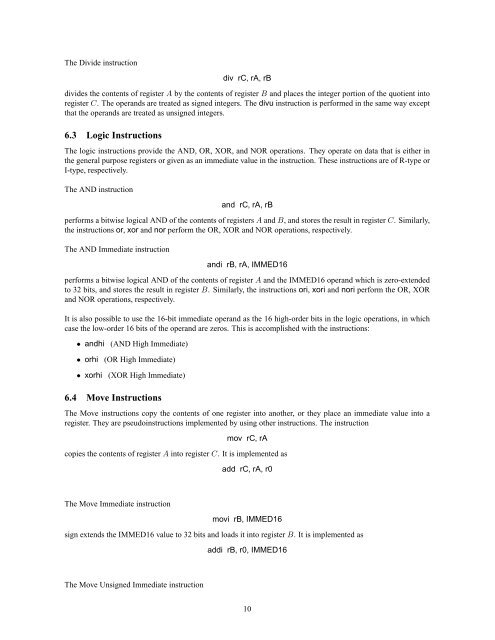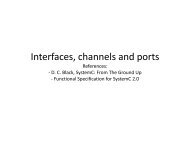Introduction to the Altera Nios II Soft Processor - FTP - Altera
Introduction to the Altera Nios II Soft Processor - FTP - Altera
Introduction to the Altera Nios II Soft Processor - FTP - Altera
You also want an ePaper? Increase the reach of your titles
YUMPU automatically turns print PDFs into web optimized ePapers that Google loves.
The Divide instruction<br />
div rC, rA, rB<br />
divides <strong>the</strong> contents of register A by <strong>the</strong> contents of register B and places <strong>the</strong> integer portion of <strong>the</strong> quotient in<strong>to</strong><br />
register C. The operands are treated as signed integers. The divu instruction is performed in <strong>the</strong> same way except<br />
that <strong>the</strong> operands are treated as unsigned integers.<br />
6.3 Logic Instructions<br />
The logic instructions provide <strong>the</strong> AND, OR, XOR, and NOR operations. They operate on data that is ei<strong>the</strong>r in<br />
<strong>the</strong> general purpose registers or given as an immediate value in <strong>the</strong> instruction. These instructions are of R-type or<br />
I-type, respectively.<br />
The AND instruction<br />
and rC, rA, rB<br />
performs a bitwise logical AND of <strong>the</strong> contents of registers A and B, and s<strong>to</strong>res <strong>the</strong> result in register C. Similarly,<br />
<strong>the</strong> instructions or, xor and nor perform <strong>the</strong> OR, XOR and NOR operations, respectively.<br />
The AND Immediate instruction<br />
andi rB, rA, IMMED16<br />
performs a bitwise logical AND of <strong>the</strong> contents of register A and <strong>the</strong> IMMED16 operand which is zero-extended<br />
<strong>to</strong> 32 bits, and s<strong>to</strong>res <strong>the</strong> result in register B. Similarly, <strong>the</strong> instructions ori, xori and nori perform <strong>the</strong> OR, XOR<br />
and NOR operations, respectively.<br />
It is also possible <strong>to</strong> use <strong>the</strong> 16-bit immediate operand as <strong>the</strong> 16 high-order bits in <strong>the</strong> logic operations, in which<br />
case <strong>the</strong> low-order 16 bits of <strong>the</strong> operand are zeros. This is accomplished with <strong>the</strong> instructions:<br />
• andhi<br />
(AND High Immediate)<br />
• orhi (OR High Immediate)<br />
• xorhi<br />
(XOR High Immediate)<br />
6.4 Move Instructions<br />
The Move instructions copy <strong>the</strong> contents of one register in<strong>to</strong> ano<strong>the</strong>r, or <strong>the</strong>y place an immediate value in<strong>to</strong> a<br />
register. They are pseudoinstructions implemented by using o<strong>the</strong>r instructions. The instruction<br />
mov rC, rA<br />
copies <strong>the</strong> contents of register A in<strong>to</strong> register C. It is implemented as<br />
add rC, rA, r0<br />
The Move Immediate instruction<br />
movi rB, IMMED16<br />
sign extends <strong>the</strong> IMMED16 value <strong>to</strong> 32 bits and loads it in<strong>to</strong> register B. It is implemented as<br />
addi rB, r0, IMMED16<br />
The Move Unsigned Immediate instruction<br />
10

















